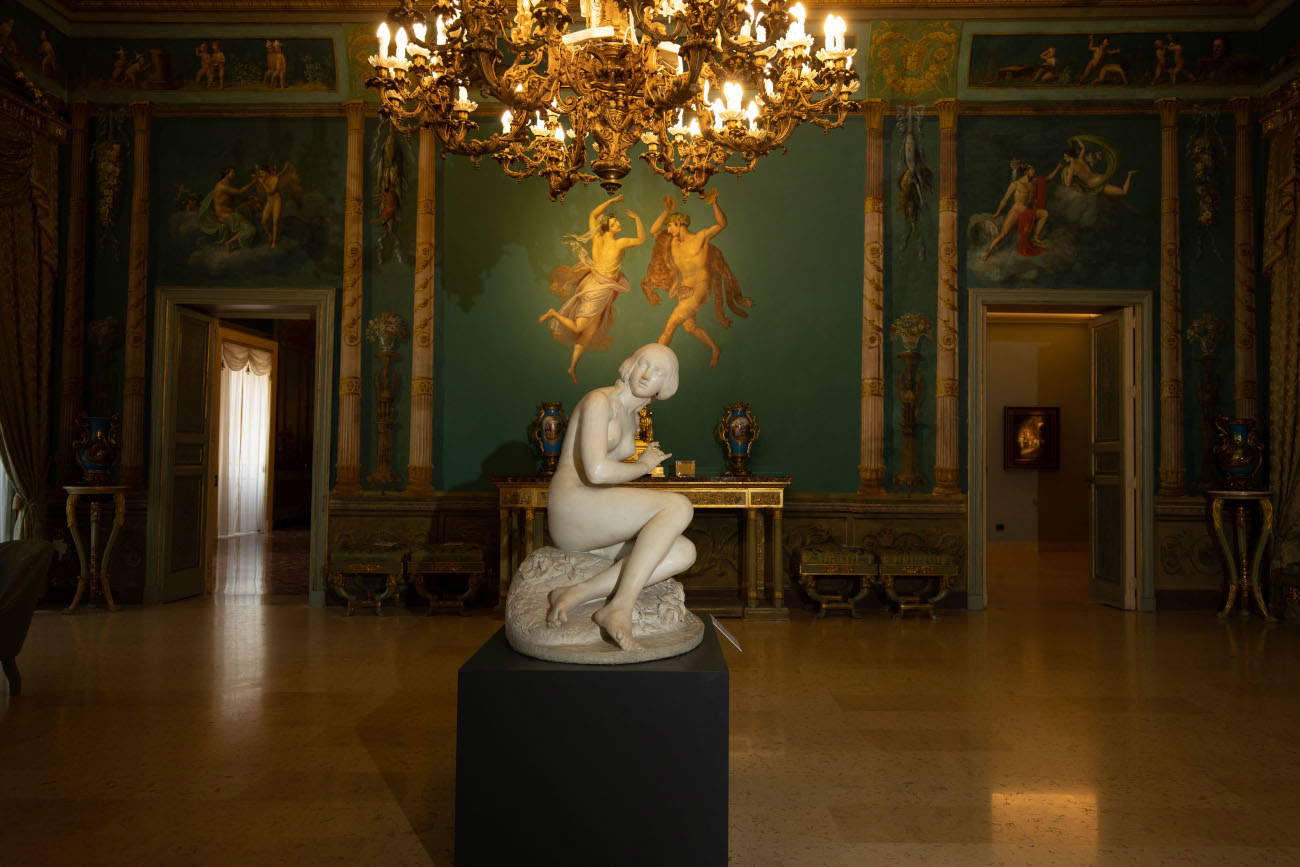Sculptural masterpieces by Antonio Canova, Giovanni Pandiani, Pietro Magni, and Giovanni Spertini have been sent on a 122-year journey from Milan to Palermo and are now on display in Palermo’s Royal Palace for the exhibition La Grande Brera al Palazzo Reale di Palermo. The Seduction of the Classic on Display, set up in the Royal Apartments of the Palace. The collaboration agreement between the Fondazione Federico II of Palermo and the Pinacoteca di Brera was presented yesterday morning in Palermo in the presence of Gaetano Galvagno, president of the Fondazione Federico II, Angelo Crespi, director general of the Pinacoteca di Brera, and Undersecretary of State at the Ministry of Culture Gianmarco Mazzi.
The exhibition features five works from Milan, a city from which they have never left since 1902: two works by Antonio Canova and three by well-known exponents of Lombard Neoclassicism, such as Giovanni Pandiani, Pietro Magni and Giovanni Spertini. The project, in addition to attracting visitors from a tourist-cultural perspective, aims to present the concept of the seduction of the classical, understood as a rich theme in Italy. In addition, for the first time on this occasion, the Frederick II Foundation is promoting the accessibility and enjoyment of cultural heritage to visitors with visual impairments: in fact, a 1:1 scale 3D reproduction of Canova’s Vestal is on display, usable by touch by the blind and visually impaired. The exhibition is intended to be an introspective journey into neoclassical culture, exalting classicism, realism and the emulation of nature.
Works by Canova, Pandiani, Magni and Spertini place visitors in front of five female figures. Antonio Canova’s Vestale, from 1818, was commissioned by Milanese banker Luigi Uboldi. It depicts a veiled young woman with an absorbed expression, characterized by refined somatic features and a striking elegance, evident especially in the skill and gracefulness with which the veil was made. The Penitent Magdalene is a poignant work, capable of highlighting the period of redemption after the conversion and encounter with Christ. It is a sculpture that recounts with extreme elegance a dramatic moment, treated by Canova with the ability to make the concept of pathos emerge from it. Egle al fonte by Giovanni Pandiani, a well-known exponent of Lombard neoclassicism, shows technical perfection and the ability to analytically reproduce the principles of the school of “the true,” highlighting anatomical and postural elements. Giovanni Spertini in La scrittrice (the Italian Girlfriend) recounts a moment of rare intimacy, with meticulous attention to every detail. Everything in the work concurs to constitute a bourgeois setting, where every detail is taken care of, contributing to an emotional and intimate scene, centered on a perfect reconstruction of reality, such as the sculptural naturalness of some locks of hair. Pietro Magni’s La leggitrice is to be included in that artistic phase that is transitioning toward the trend, just post neoclassical, oriented toward an academic realistic canon. It depicts a young girl, intent on reading, portrayed in a domestic setting, as evidenced by her bare feet emerging from her long robe.
The exhibition aims to place particular emphasis on the stylistic elements that characterize the classical features of Magna Graecia and are evident in the works on display. The exhibition, however, also engages with the enormous and coeval Sicilian artistic heritage, which is strongly influenced by the classical culture present in numerous sites in the region.



“We are particularly proud to have been able to bring to the Royal Palace of Palermo,” said Fondazione Federico II President Gaetano Galvagno, “some splendid works from the Brera Museum, which are moving from Milan after 122 years. This is the tangible result of a collaboration agreement between two leading cultural institutions, both from the permanent and temporary exhibition point of view and from the dissemination point of view. I am certain that this is the first stage of a fruitful collaboration for the benefit of the community.”
“This is a first initiative, inaugurating a partnership between the two cultural institutions and the two cities,” said Brera Art Gallery Director General Angelo Crespi. “The exhibition, as essential as it is clear in its cultural aims, is realized through a restricted selection of works, capable of fully expressing their character and history. Exposing is a polysense term: it means explaining, interpreting and narrating, in an accomplished and organic form. In the exhibition halls of the Royal Palace, the works of Brera will be narrated and enter into dialogue with the architecture and the cultural and testimonial values of a place that emanates beauty and, together, the profound sense of dialogue between cultures. For Brera, it will be a return to its origins, to the body of sculpture works expunged from the collections in 1902. In Palermo, Brera will experience a return to the original meaning of its collections, not coincidentally in a profound dialogue with an ”incomparable land."
“We inaugurate today an event of great importance. An event that carries with it a symbolic and formal value in the sign of the nation’s cultural unity and the enhancement of Italian art,” said Undersecretary for Culture Gianmarco Mazzi. “The Pinacoteca di Brera and the Fondazione Federico II have reached a far-sighted agreement that will allow all Sicilians to be able to admire, at the Royal Palace, works of immeasurable beauty.”



 |
| Masterpieces by Canova and Lombard Neoclassicism move from Brera to Palermo after 122 years |
Warning: the translation into English of the original Italian article was created using automatic tools. We undertake to review all articles, but we do not guarantee the total absence of inaccuracies in the translation due to the program. You can find the original by clicking on the ITA button. If you find any mistake,please contact us.